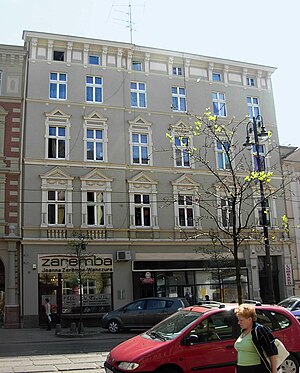Aleksander Olszyński Building
| Aleksander Olszyński Tenement | |
|---|---|
Polish: Kamienica Aleksandra Olszyńskiego | |
 Tenement at N°58 Gdańska Street | |
 | |
| General information | |
| Type | Tenement |
| Architectural style | Neo-Renaissance & Neo-Baroque, with Eclecticism style elements |
| Location | Gdanska Street 58, Bydgoszcz, Poland |
| Coordinates | 53°7′51″N 18°0′32″E / 53.13083°N 18.00889°E |
| Groundbreaking | 1894 |
| Completed | 1895 |
| Client | Aleksander Olszyński |
| Technical details | |
| Floor count | 4 |
| Design and construction | |
| Architect(s) | Henrich Arndt |
The Aleksander Olszyński Tenement is a habitation house built in the late 19th century from a design by architect Heinrich Arndt in Bydgoszcz,[1] Poland, and located at Gdanska Street 58.
Location
The building stands on the eastern side of Gdanska Street, between Słowackiego street and Adam Mickiewicz Alley. It is adjacent to the Chapel of the Sisters of the Poor Clares at N.56 and the Carl Meyer tenement at N.60, both Bydgoszcz historical buildings.
History
The building was erected in 1894-1895 for the carpenter Alexander Olszyński,[2] living at this time at Boiestrasse 1, on a design by Heinrich Arndt, a Bromberg master mason.[1]
In 1910, the ground floor was refurbished by designer Gustav Habermann to accommodate a business venture. Before the outbreak of World War One, the building housed the offices of the "German Association for People's Health in Bydgoszcz".
In the 1920s, Kochańscy Brothers & Kunzle (Polish: Bracia Kochańscy i Künzl) run a jewelry shop in the premises,[3] manufacturing gold and silver products. During the occupation of Poland, the building housed the main store of the Württemberg metal goods factory (German: WMF-Württemberger MetallwarenFabrik).
Architecture
One can still notice preserved and rich, Neo-Renaissance and Neo-Baroque stucco decoration of the facade. Many original forms of the eclectic architectural details are also present, in particular the adorned wooden main door with a transom light.
Gallery
-
Main door and transom light
See also
- Bydgoszcz
- Gdanska Street in Bydgoszcz
- Example (edit | talk | history | links | watch | logs) Downtown district of Bydgoszcz
References
- ^ a b Fritz Gerstenberg. "Nachrufe der Graunschweigischen Wissenschaftlichen Gesellschaft" (PDF). UB Braunschweig. Von Hermann Lagershausen. Retrieved 12 March 2015.
Dr.-Ing. Hermann Arndt, geb. 15.12.1885, gest. 8.6.1963, wurde zu Schleusenau bei Bromberg (Prov. Posen) als Sohn des Maurermeisters Heinrich Arndt geboren.
- ^ Adressbuch nebst allgemeinem Geschäfts-Anzeiger von Bromberg und dessen Vororten auf das Jahr 1895 : auf Grund amtlicher und privater Unterlagen. Bromberg: Dittmann. 1895. p. 122.
- ^ Adresy Miasta Bydgoszcz na rok 1925. Bydgoszcz: Weber. 1925. p. 140.
Bibliography
- Example (edit | talk | history | links | watch | logs) Bręczewska-Kulesza Daria, Derkowska-Kostkowska Bogna, Wysocka A., [i inni]: Ulica Gdańska. Przewodnik historyczny, Bydgoszcz 2003
- Example (edit | talk | history | links | watch | logs) Kronika Bydgoska T. 21 (1999), Towarzystwo Miłośników Miasta Bydgoszczy, Bydgoszcz 2000

